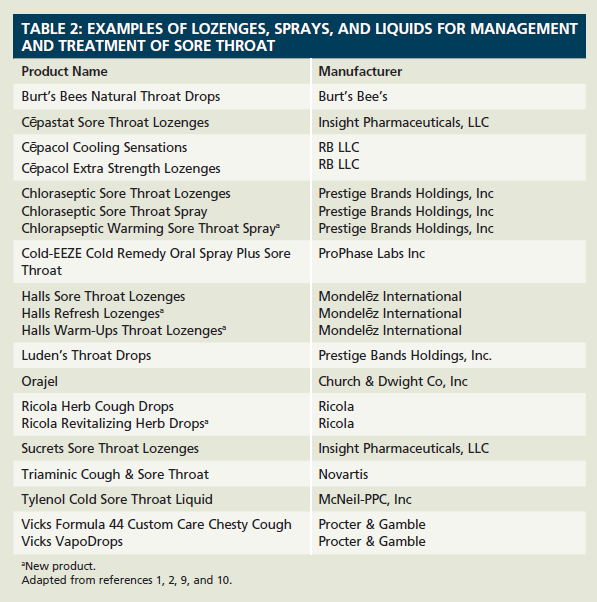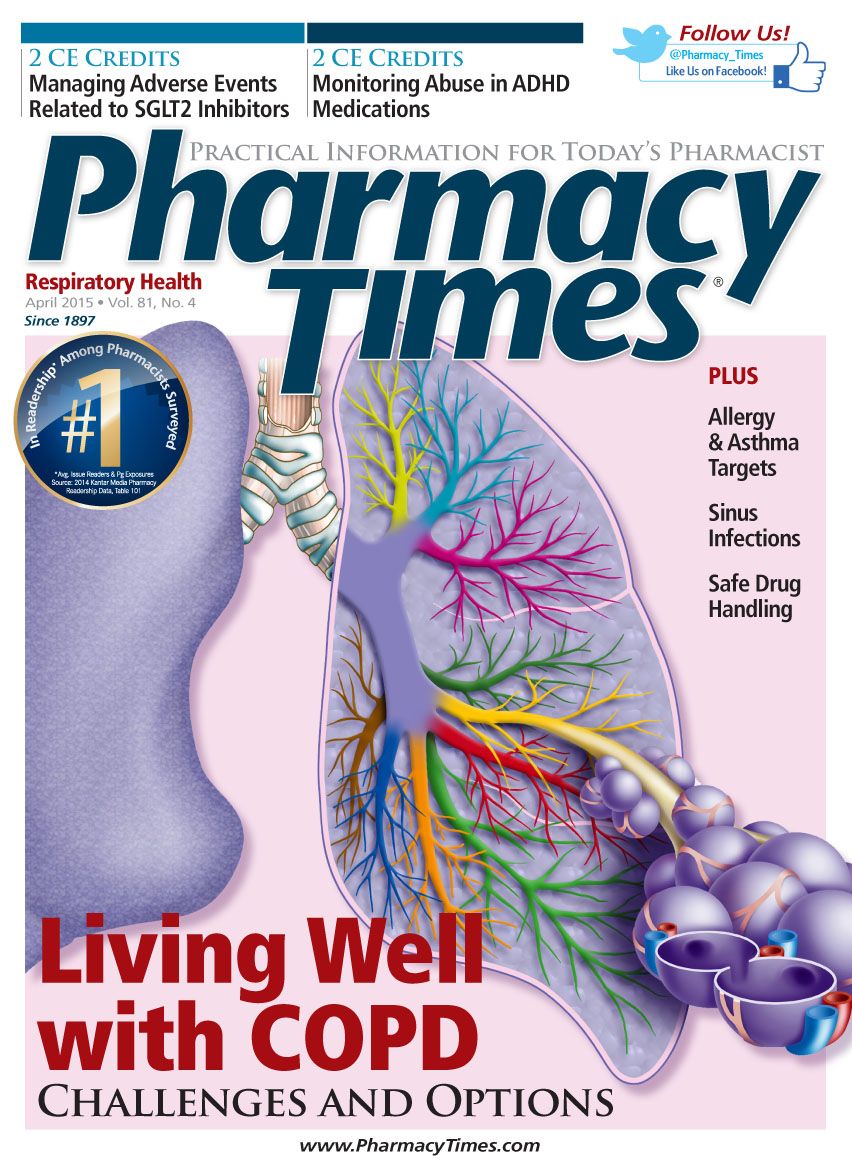Sore Throat: Easing the Pain
Finding relief is a top priority for anyone experiencing the pain and discomfort often associated with a sore throat, or pharyngitis.
Finding relief is a top priority for anyone experiencing the pain and discomfort often associated with a sore throat, or pharyngitis.
Patients complaining of a sore throat may present with symptoms such as difficulty swallowing accompanied by pain, tenderness, irritation, or swelling in the throat.1,2 In addition, depending on the cause, patients may present with fever, headache, white patches in the throat or tonsils, red or swollen tonsils, and a general feeling of malaise.1,2
Although a host of conditions and factors can cause a sore throat, the majority of cases are caused by cold and flu viruses (Online Table 1).1-3 Sore throats are typically the first symptom noted at the onset of a cold, followed by nasal symptoms.4 Sore throats caused by viruses usually resolve on their own within a few days.1-3 Strep throat is the most common cause of bacterial infections of the throat.1-3
TABLE 1: CAUSES OF SORE THROAT OTHER THAN COLD OR FLU
- Allergies (chronic postnasal drip)
- Exposure to environmental irritants such as smoke, chemicals, or pollution
- Mononucleosis
- Strep throat
- Tonsillitis
- Gastroesophageal reflux disease
- Excessive coughing, yelling, and screaming
Adapted from references 1-3.
Statistics show that an estimated 70% of individuals who present with sore throat receive antibiotics. In 2012, however, guidelines from the Infectious Diseases Society of America (IDSA) attempted to increase awareness about limiting the use of antibiotics for throat infections caused by viruses and to correctly identify and treat throat infections caused by group A streptococcal (strep) bacteria.5,6 Unfortunately, since other studies also report that doctors are prescribing antibiotics for sore throats more often than they should, it is important to increase awareness of antibiotic resistance and stress that antibiotics will not help in treating a viral infection.5,7
The IDSA guidelines offer health care providers recommendations regarding when to test for and how to treat strep throat.5,6 The guidelines note that even though bacterial and viral throat infections often present with similar symptoms, cough, oral ulcers, hoarseness, and rhinorrhea strongly imply the presence of a viral infection.5,6 In a patient presenting with the sudden onset of pain when swallowing in addition to a fever, however, the cause is most likely strep; these patients should be evaluated with a rapid antigen test or a throat culture to determine whether the patient has strep throat.5,6 Strep throat can affect anyone, but its occurrence is more common in children aged 5 to 15 years. The condition can be treated effectively with antibiotics.8

Managing and Treating Sore Throat
Although the majority of sore throats resolve without treatment, various nonprescription products—including sugarfree formulations—can provide symptomatic relief (Table 21,2,9,10). In general, the selected treatment depends on the cause of the sore throat.1,2,9 These products may contain local anesthetics, such as benzocaine or dyclonine hydrochloride, which provide temporary relief of sore throat pain.4 Nonprescription products are formulated as lozenges and throat sprays and may be used every 2 to 4 hours as needed.4 Some products also contain local antiseptics (eg, cetylpyridinium chloride or hexylresorcinol) and/ or camphor or menthol.
New product formulations include Chloraseptic Warming Sore Throat Spray (Prestige Brands Holdings) to soothe sore throat and Halls Warm-Ups Throat Lozenges (Mondelēz International) with menthol vapors that cool nasal passages and provide a sensation of warmth to sooth the throat. Other new products include Halls Refresh Lozenges, which soothe the discomfort associated with a dry throat, and Sucrets Sore Throat Lozenges (Insight Pharmaceuticals, LLC). Lozenges appear to be the most commonly used OTC product for treating the pain and discomfort associated with a sore throat. During counseling about these products, pharmacists should remind patients who have a history of allergies to local anesthetics to avoid products that contain benzocaine or other local anesthetics.4 Patients should also be reminded to use these products as directed. If no contraindications are present, some health care providers may suggest taking an analgesic, such as acetaminophen or a nonsteroidal anti-inflammatory drug, to ease pain.4 Patients should be advised to also gargle with warm salt water, use a humidifier to add moisture to the air, and drink plenty of fluids.
The Pharmacist’s Role
Pharmacists are in a pivotal position to direct patients presenting with sore throat symptoms to seek medical care from their primary health care provider when warranted, especially when signs of infection are present or if symptoms are accompanied by swollen glands, fever, rash, headache, nausea, and/or vomiting.4
Patients with recurring sore throat or a sore throat that lasts longer than 5 to 7 days should seek further medical care from their primary health care provider.1,4 Patients suspected of having strep throat should be reminded that this bacterial infection is very contagious and that the contagious period is typically over after the individual has been on antibiotics for 24 hours.11 Patients with strep throat should be reminded to complete their entire course of antibiotic therapy, even if they are feeling better.9,11 Pharmacists can also provide patients with valuable information regarding nonpharmacologic measures to ease and prevent sore throat (Online Table 3).1,2,9,10
TABLE 3: NONPHARMACOLOGIC PREVENTION AND MANAGEMENT OF SORE THROAT
Sore throat prevention:
- Because the majority of sore throats are caused by viruses and bacteria, practice infection control and hygiene procedures such as routine handwashing and use of hand sanitizers when soap and water are not available.
- Avoid allergens and irritants when possible.
- When possible, avoid being around individuals who are sick.
Sore throat management:
- Sip warm liquids such as tea with lemon or honey.
- Gargle with warm salt water (1/2 teaspoon of salt in 8 ounces of water) several times a day.
- Use cold liquids or ice chips to soothe throat pain.
- Use throat lozenges or sprays when appropriate. In pediatric patients, only use products formulated for children; when in doubt, consult your primary health care provider.
- Use a cool-mist vaporizer or humidifier to moisten the air and soothe a dry and painful throat.
- Eat hard candies to increase the production of saliva, which eases irritation. Avoid use in children because of choking hazard.
- If no contraindications or drug interactions, use OTC analgesics such as acetaminophen.
Adapted from references 1, 2, 9, and 10.
Ms. Terrie is a clinical pharmacy writer based in Haymarket, Virginia.
References
- Sore throats. American Academy of Otolaryngology—Head and Neck Surgery website. www.entnet.org/content/sore-throats. Accessed February 15, 2015.
- Sore throat. Medline Plus website. www.nlm.nih.gov/medlineplus/sorethroat.html.
- Sore throat. Mayo Clinic website. www.mayoclinic.org/diseases-conditions/sore-throat/basics/causes/con-20027360. Accessed February 15, 2015.
- Scolaro K. Disorders related to cold and allergy. In: Krinsky D, Berardi R, Ferreri S, et al, eds. Handbook of Nonprescription Drugs. 17th ed. Washington, DC: American Pharmacists Association; 2012.
- Waknine Y. Sore throats mostly viral, not strep. Medscape website. www.medscape.com/viewarticle/771093. Accessed February 15, 2015.
- Shulman ST, Bisno AL, Clegg HW, et al. Clinical practice guideline for the diagnosis and management of group A streptococcal pharyngitis: 2012 update by the Infectious Diseases Society of America. Clin Infect Dis. 2012;55(10):e86-e102. http://cid.oxfordjournals.org/content/early/2012/09/06/cid.cis629.full. Accessed February 15, 2015.
- Harrison L. Antibiotics still overprescribed for sore throats, bronchitis. Medscape website www.medscape.com/viewarticle/812109. Accessed February 15, 2015.
- Is it strep throat? NIH National Institute of Allergy and Infectious Disease website. www.niaid.nih.gov/topics/strepthroat/Pages/Default.aspx. Accessed February 15, 2015.
- Sore throat. Centers for Disease Control and Prevention website. www.cdc.gov/getsmart/antibiotic-use/URI/sore-throat.html. Accessed February 15, 2015.
- Vorvick LJ. Pharyngitis - sore throat. Medline Plus website. www.nlm.nih.gov/medlineplus/ency/article/000655.htm. Accessed February 15, 2015.
- Vorvick LJ. Strep throat. Medline Plus website. www.nlm.nih.gov/medlineplus/ency/article/000639.htm. Accessed February 15, 2015.

